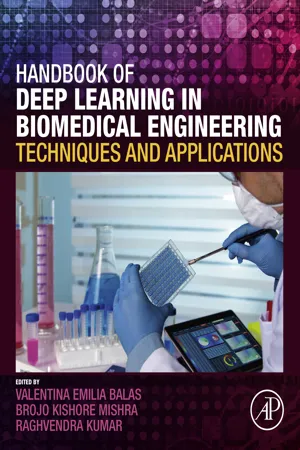
Handbook of Deep Learning in Biomedical Engineering
Techniques and Applications
Valentina Emilia Balas,Brojo Kishore Mishra,Raghvendra Kumar
- 320 Seiten
- English
- ePUB (handyfreundlich)
- Über iOS und Android verfügbar
Handbook of Deep Learning in Biomedical Engineering
Techniques and Applications
Valentina Emilia Balas,Brojo Kishore Mishra,Raghvendra Kumar
Über dieses Buch
Deep Learning (DL) is a method of machine learning, running over Artificial Neural Networks, that uses multiple layers to extract high-level features from large amounts of raw data. Deep Learning methods apply levels of learning to transform input data into more abstract and composite information. Handbook for Deep Learning in Biomedical Engineering: Techniques and Applications gives readers a complete overview of the essential concepts of Deep Learning and its applications in the field of Biomedical Engineering. Deep learning has been rapidly developed in recent years, in terms of both methodological constructs and practical applications. Deep Learning provides computational models of multiple processing layers to learn and represent data with higher levels of abstraction. It is able to implicitly capture intricate structures of large-scale data and is ideally suited to many of the hardware architectures that are currently available. The ever-expanding amount of data that can be gathered through biomedical and clinical information sensing devices necessitates the development of machine learning and AI techniques such as Deep Learning and Convolutional Neural Networks to process and evaluate the data. Some examples of biomedical and clinical sensing devices that use Deep Learning include: Computed Tomography (CT), Magnetic Resonance Imaging (MRI), Ultrasound, Single Photon Emission Computed Tomography (SPECT), Positron Emission Tomography (PET), Magnetic Particle Imaging, EE/MEG, Optical Microscopy and Tomography, Photoacoustic Tomography, Electron Tomography, and Atomic Force Microscopy. Handbook for Deep Learning in Biomedical Engineering: Techniques and Applications provides the most complete coverage of Deep Learning applications in biomedical engineering available, including detailed real-world applications in areas such as computational neuroscience, neuroimaging, data fusion, medical image processing, neurological disorder diagnosis for diseases such as Alzheimer's, ADHD, and ASD, tumor prediction, as well as translational multimodal imaging analysis.
- Presents a comprehensive handbook of the biomedical engineering applications of DL, including computational neuroscience, neuroimaging, time series data such as MRI, functional MRI, CT, EEG, MEG, and data fusion of biomedical imaging data from disparate sources, such as X-Ray/CT
- Helps readers understand key concepts in DL applications for biomedical engineering and health care, including manifold learning, classification, clustering, and regression in neuroimaging data analysis
- Provides readers with key DL development techniques such as creation of algorithms and application of DL through artificial neural networks and convolutional neural networks
- Includes coverage of key application areas of DL such as early diagnosis of specific diseases such as Alzheimer's, ADHD, and ASD, and tumor prediction through MRI and translational multimodality imaging and biomedical applications such as detection, diagnostic analysis, quantitative measurements, and image guidance of ultrasonography
Häufig gestellte Fragen
Information
Inhaltsverzeichnis
- Cover image
- Title page
- Table of Contents
- Copyright
- Contributors
- About the editors
- Preface
- Key features
- About the book
- 1. Congruence of deep learning in biomedical engineering: future prospects and challenges
- 2. Deep convolutional neural network in medical image processing
- 3. Application, algorithm, tools directly related to deep learning
- 4. A critical review on using blockchain technology in education domain
- 5. Depression discovery in cancer communities using deep learning
- 6. Plant leaf disease classification based on feature selection and deep neural network
- 7. Early detection and diagnosis using deep learning
- 8. A review on plant diseases recognition through deep learning
- 9. Applications of deep learning in biomedical engineering
- 10. Deep neural network in medical image processing
- Index